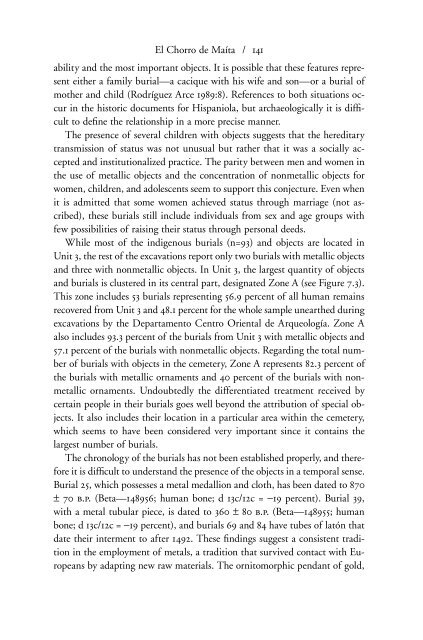Dialogues in Cuban Archaeology
by L. Antonio Curet, Shannon Lee Dawdy, and Gabino La Rosa Corzo
by L. Antonio Curet, Shannon Lee Dawdy, and Gabino La Rosa Corzo
You also want an ePaper? Increase the reach of your titles
YUMPU automatically turns print PDFs into web optimized ePapers that Google loves.
El Chorro de Maíta / 141<br />
ability and the most important objects. It is possible that these features represent<br />
either a family burial—a cacique with his wife and son—or a burial of<br />
mother and child (Rodríguez Arce 1989:8). References to both situations occur<br />
<strong>in</strong> the historic documents for Hispaniola, but archaeologically it is dif¤cult<br />
to de¤ne the relationship <strong>in</strong> a more precise manner.<br />
The presence of several children with objects suggests that the hereditary<br />
transmission of status was not unusual but rather that it was a socially accepted<br />
and <strong>in</strong>stitutionalized practice. The parity between men and women <strong>in</strong><br />
the use of metallic objects and the concentration of nonmetallic objects for<br />
women, children, and adolescents seem to support this conjecture. Even when<br />
it is admitted that some women achieved status through marriage (not ascribed),<br />
these burials still <strong>in</strong>clude <strong>in</strong>dividuals from sex and age groups with<br />
few possibilities of rais<strong>in</strong>g their status through personal deeds.<br />
While most of the <strong>in</strong>digenous burials (n=93) and objects are located <strong>in</strong><br />
Unit 3, the rest of the excavations report only two burials with metallic objects<br />
and three with nonmetallic objects. In Unit 3, the largest quantity of objects<br />
and burials is clustered <strong>in</strong> its central part, designated Zone A (see Figure 7.3).<br />
This zone <strong>in</strong>cludes 53 burials represent<strong>in</strong>g 56.9 percent of all human rema<strong>in</strong>s<br />
recovered from Unit 3 and 48.1 percent for the whole sample unearthed dur<strong>in</strong>g<br />
excavations by the Departamento Centro Oriental de Arqueología. Zone A<br />
also <strong>in</strong>cludes 93.3 percent of the burials from Unit 3 with metallic objects and<br />
57.1 percent of the burials with nonmetallic objects. Regard<strong>in</strong>g the total number<br />
of burials with objects <strong>in</strong> the cemetery, Zone A represents 82.3 percent of<br />
the burials with metallic ornaments and 40 percent of the burials with nonmetallic<br />
ornaments. Undoubtedly the differentiated treatment received by<br />
certa<strong>in</strong> people <strong>in</strong> their burials goes well beyond the attribution of special objects.<br />
It also <strong>in</strong>cludes their location <strong>in</strong> a particular area with<strong>in</strong> the cemetery,<br />
which seems to have been considered very important s<strong>in</strong>ce it conta<strong>in</strong>s the<br />
largest number of burials.<br />
The chronology of the burials has not been established properly, and therefore<br />
it is dif¤cult to understand the presence of the objects <strong>in</strong> a temporal sense.<br />
Burial 25, which possesses a metal medallion and cloth, has been dated to 870<br />
± 70 b.p. (Beta—148956; human bone; d 13c/12c = −19 percent). Burial 39,<br />
with a metal tubular piece, is dated to 360 ± 80 b.p. (Beta—148955; human<br />
bone; d 13c/12c = −19 percent), and burials 69 and 84 have tubes of latón that<br />
date their <strong>in</strong>terment to after 1492. These ¤nd<strong>in</strong>gs suggest a consistent tradition<br />
<strong>in</strong> the employment of metals, a tradition that survived contact with Europeans<br />
by adapt<strong>in</strong>g new raw materials. The ornitomorphic pendant of gold,


















